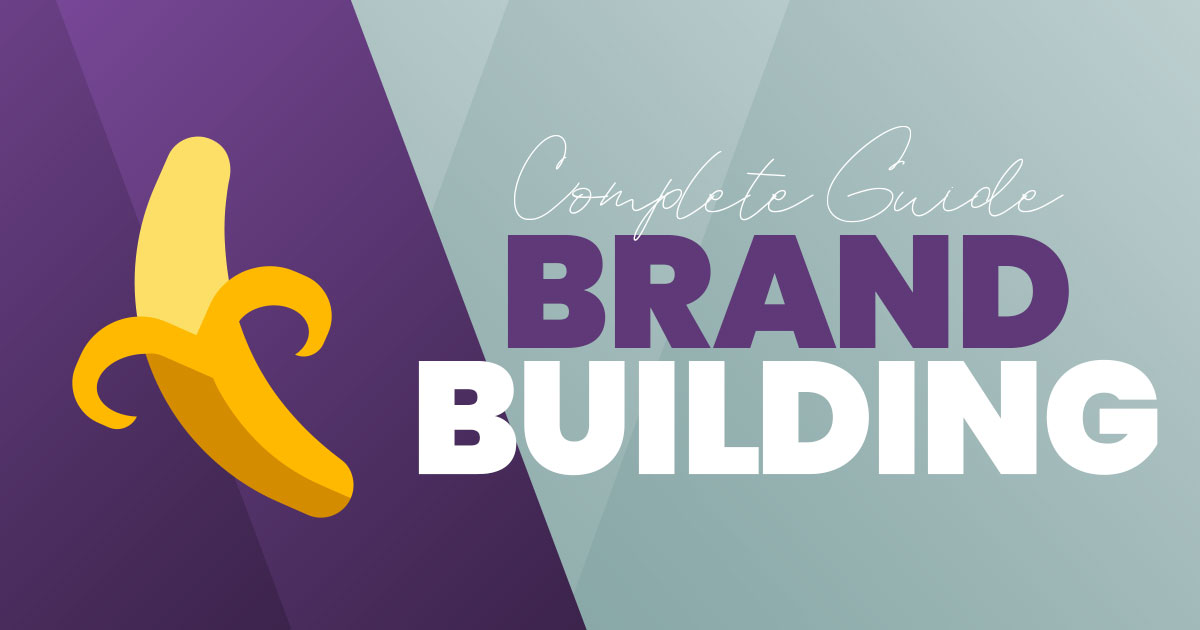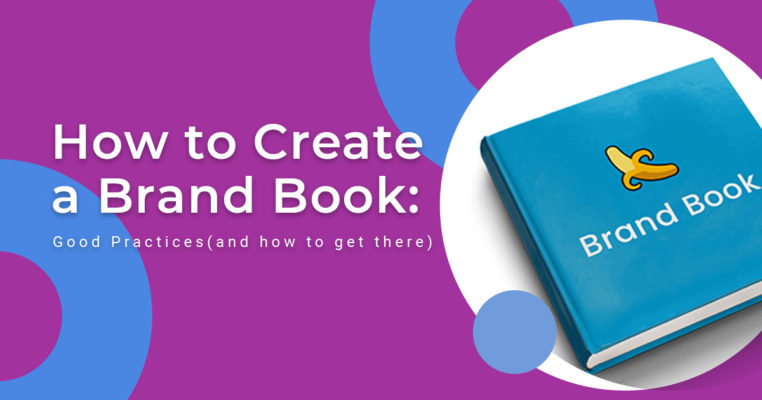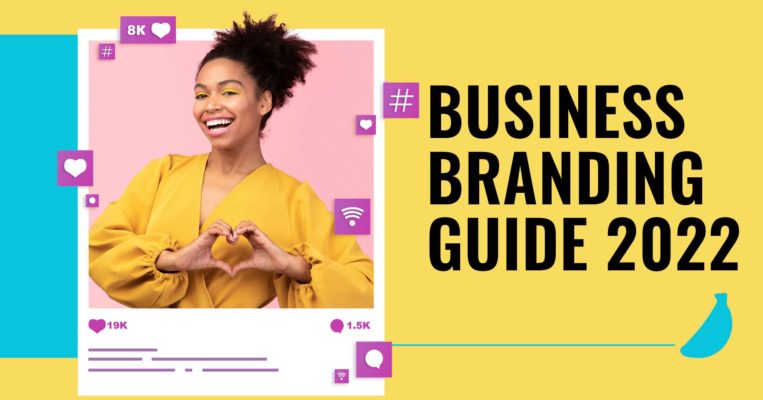Brands are not just logos and slogans. They’re people’s perceptions of everything your brand says and does. Successful brand building will not only make customers choose you over the competition, but it’ll ensure that they’ll remain loyal for years to come.
Today, we’ll be diving into brand building and taking a look at how you can successfully build your brand.
What is brand building?
Brand building is the process of creating a unique identity for a product or company, one that separates it from the competition. It’s about finding a way to make consumers feel like they need your product or service, sometimes even almost making them feel like they can’t live without it.
There are many different ways to build a brand, but some of the most common techniques include:
- creating a strong visual identity,
- crafting a good business strategy,
- planning digital marketing activities,
- building core brand positioning,
- developing a powerful marketing message,
- and building an emotional connection with consumers.
Of course, the critical step is to stay true to your brand values and never compromise on quality.
In order to successfully build a brand, it’s essential to first understand what brand building really means and why it’s important for businesses.
Benefits of brand building for businesses
Brand building helps businesses to create a name for themselves and become recognizable
When customers know who you are, they’re more likely to follow your brand and be more likely to buy from you. You’ll be seen as an authority!
Brand building can also help businesses to attract new customers, as well as retain the ones they already have. Loyal customers are more likely to stick with a brand that they trust and feel connected to, while new customers will be more likely to try a brand that they’ve heard good things about.
Brand building can help businesses to stand out from their competitors
You can gain a foothold in your industry with recognizable branding. When brand building is successful, it’s likely that you’ll become the brand of choice for customers and see an increase in sales as a result.
It builds trust between the business and the customer
Customers are more likely to do business with a brand that they are familiar with. When you take the time to build a strong brand, customers will feel like they know what to expect from you and will be more likely to invest in their relationship with your company.
Brand building is an important part of marketing
Brand building works towards the perception that people have of your company. And, as we all know, perception is everything in business. By building a strong brand, you are paving the way to success.
By creating a brand, businesses can create a lasting impression on customers
Your persuaded customers will keep them coming back for years to come. So, if you’re looking to build a successful business, brand building is an essential component that you can’t afford to ignore.
More opportunities for partnerships and collaborations
When you build a brand, it becomes much easier to partner with other businesses and collaborate. Your brand is already recognized by customers as an industry leader – so reaching out to others that share the same values can be beneficial for both parties involved.
How do you build a strong brand?
There are a few factors you need to consider, find out and answer before you even start working on your branding strategy.
first things first, as they say
#1 identify your niche
The first step in brand building is identifying your niche. What are you good at? What do you stand for? Once you’ve identified your niche, focus all of your marketing efforts on that target market. However, make sure that you don’t alienate other potential customers in the process – you still want to be as accessible as possible.
#2 find your company’s story
Every brand has a story, and it’s important to find yours and tell it in a way that engages customers. Your story should be unique to your company and reflect the values and the culture of its employees. This step is extremely essential because it will help you to create all of your marketing materials and communicate your brand’s message effectively.
#3 develop a powerful marketing message
Your marketing message is what will set you apart from the competition and convince customers that they need your product or service. It should be clear, concise, and relevant to your target audience. Make sure to communicate it in every piece of marketing material you produce.
#4 define the values that are important to you and your company
When you know what your brand stands for, it becomes much easier to communicate these values to customers. Define the core values that are important to you and make sure that they’re reflected in everything you do – from the products you sell to the way you treat your employees.
#5 establish a brand voice that is unique to your company
Your brand voice should be consistent across all of your marketing materials. It should be professional, yet approachable and engaging – think of it as the tone of your company. What’s more, it needs to be distinctive, so that customers understand who you are and what makes your brand different from the rest.
#6 research your competitors
It’s important to know what your competition is doing, so that you can differentiate yourself from them. What are they offering customers that you’re not? How do their branding and marketing materials look? What can you learn from them to make sure that your brand stands out in the crowd? This knowledge can help you build a competitive advantage.
#7 find a reason for others to love your brand
When people love your brand, they’ll be more likely to tell others about it. Find a way to show your customers that you appreciate them and that you’re committed to providing them with the best possible experience. Make them feel special and let them know that you value their business.
#8 establish your target audience
Your brand needs to be relevant and relatable to your target audience, so it’s important to define them before you move forward with the rest of your brand building activities. Who are they? What do they value in a company? How will you communicate with them most effectively? The more questions you can get answered, the better.
#9 create products that solve customer problems
At this point, you should have a good understanding of who your target audience is and what they’re looking for. Use this information to create products and services that solve customer problems – after all, that’s what they’re buying from you. When you can fulfill their needs, they’ll be more likely to stick with your brand in the long run.
creative process
#1 get a big idea
When it comes to brand building, you don’t want to start with the mini stuff. Come up with a big idea that will really capture people’s attention and then work backwards, creating all of your marketing materials around that one concept. This will help ensure that your brand is cohesive and memorable.
#2 come up with an idea of tagline
A brand tagline is a short phrase that describes what your brand stands for. It should be simple and easy to remember, and it’s often used as the basis of all brand messaging.
Taglines are different from slogans in the context of branding. They are phrases that serve as permanent expressions of your company’s mission. Your tagline should be recognizable with your brand, long-lasting, and able to attract customers as well as remain top-of-mind with your existing audience.
What are some examples of great brand taglines?
Some popular brand taglines include:
- “Empowering you to do more” (Dell)
- “Do the right thing” (Intel)
- “Making technology accessible to everyone” (Lenovo)
- “Just do it” (Nike)
#3 create an original set of slogans for products, services, and marketing campaigns
Your brand slogan should be short and catchy, so that customers can easily remember it. It should also reflect your brand’s message and personality – the way you want potential customers to see you.
If you have a few lines of products or services, you should consider creating various slogans for them.
#4 think outside the box
The best way to create a brand that has an edge is to think outside the box. Be creative and come up with ideas that haven’t been done before. This will help you to stand out from the competition and attract attention from customers.
#5 be authentic
Don’t try to be something you’re not – it will only end up confusing customers. Authenticity is key when it comes to brand building. Be true to your company’s values and the message you want to communicate to customers.
#6 stay consistent
Make sure that all of your marketing materials are aligned with your brand identity, and that the tone of voice is consistent across all platforms. This will help ensure that customers have a positive perception of your brand.
design process
#1 make a brand book
A brand book is a great way to keep your branding consistent across all of your marketing materials. It’s essentially a guide that outlines the look, feel, and tone of your brand, as well as the fonts and colors you should use. This document should be updated regularly as your brand evolves, and the entire process of working on it never really finishes as there may be changes on the way!
Brand imaging is a great way to create visual consistency across all of your marketing materials. It’s the use of specific elements that help customers to identify your brand. When used correctly, it can be extremely effective in building brand recognition and business growth.
#2 pick the right color palette
Colors play a huge role in branding, and it’s important to choose the right ones. They should reflect the values of your company and be consistent with your marketing message. How to pick the best colors for your brand? That’s a good question. It depends on what you’re hoping to achieve with your brand. Some colors are associated with certain emotions or feelings, so you’ll want to choose colors that will help to reflect the image you want your brand to portray.
For example, cool colors like blue and green can be calming and soothing, while warm colors like red and orange can be exciting and stimulating. If you want your brand to come across as modern and progressive, you might choose cool colors, whereas if you want it to appear more traditional or classic, warmer colors might be a better choice.
There’s no right or wrong answer – it’s all about choosing the colors that will most accurately reflect the image you want your brand to have.
#3 create a logo with an identifiable design
Your brand logo should be recognizable so that customers can identify your brand at a single glance.
A logo is the visual representation of your brand. It’s what people will see on social media, in print materials, or when they visit your website – so it has to look good no matter what the placement is. A good logo should be representative of what you stand for–both visually and symbolically.
A good logo is something that is simple, memorable, and timeless. It should also be versatile and legible in different sizes and formats.
A great way to create a good logo is to start with a basic shape or symbol. The design should be simple so that it can be easily reproduced and remembered. For many, it’s important to make sure the logo will still look good 10 or 20 years from now.
If you’re looking for some inspiration here, check Logo Modernism – one of the best books
and resources on great logos from all over the world.
#4 don’t forget about fonts
Fonts are an essential part of business branding.
There’s no one-size-fits-all answer to this question, as the best font for your business will vary depending on your industry and target audience. However, here are a few tips to help you choose the right font for your business:
- Make sure the font is easy to read. Consumers are more likely to trust businesses that have easy-to-read fonts.
- There are thousands out there to choose from, but most brands stick with two or three.
- Choose a font that reflects your company’s branding. If you want your company to seem fun and youthful, choose a playful font; if you want it to seem professional and trustworthy, choose a more traditional font.
- Test out several different fonts – both in online and offline materials – before making a final decision.
- Again, keep them simple and consistent with the overall look and feel of your brand.
#5 make sure there’s consistency throughout all of your marketing materials
Your brand imaging should be consistent across all of your marketing materials, from the products you sell to the way you answer customer emails. This is a great opportunity for customers to identify and connect with your brand – make sure that it’s done right!
#6 use brand imaging strategically
A style guide will help to ensure that all of your marketing materials are visually consistent and on-brand. It should include brand guidelines for everything from fonts and imagery, to logo usage.
Once you’ve established your brand identity – the words or images that people associate with your brand – it should guide all of your other brand building efforts moving forward. Keep in mind that this can take some time to develop properly!
Take into account what messages you want to convey with each word choice and design element, and make sure that your brand imaging is supporting those messages.
brand building execution
#1 build brand awareness
The first step in brand building is increasing brand awareness. You want as many people as possible to be aware of your brand, so that they’ll consider buying from you when the time comes.
There are many different ways to increase brand awareness, but some of the most common include:
- advertising (TV, radio, print, online)
- PR (press releases, interviews with journalists or bloggers, brand mentions on other websites)
- social media marketing (posts on Facebook, Twitter, Instagram, etc.)
- sponsorship (events, teams, individuals)
- word of mouth (positive customer experiences that encourage others to try your brand)
Make sure that all aspects of your business are in line with your brand identity and web design.
#2 work on brand positioning
Once you’ve increased brand awareness, the next step is to build brand positioning. This means that your brand should be seen as a leader in its particular niche – one of the best! The goal here is for customers to see you as an authority on your topic or industry. If they do, then there’s a much better chance that they’ll buy from you.
The most common methods of positioning a brand include the following:
- developing a strong brand identity
- creating great brand content
- being consistent in the quality of your products or services
- focusing on customer service
#3 develop brand equity definition and valuation
Once you’ve increased brand awareness and built brand positioning, the next step is to develop brand equity. This is a measure of how much customers trust and value your brand. The higher the brand equity, the more likely customers are to buy from you.
Brand equity can be developed through many different methods, but some of the most popular include:
- brand loyalty programs
- brand endorsements from influential people
- good customer service and support
If you’re going to invest in building brand equity, make sure it’s sustainable. This means that your efforts should be long-term – not a one-off marketing push or short-term program.
Finally, it’s important to remember that brand building is an ongoing process. You should be constantly reviewing your branding efforts and making adjustments as necessary. It can take time for brands to build up trust and value, but with a little patience and hard work, you can achieve great things!
#4 work on brand voice development (for customer interactions)
Another brand building component is brand voice. This refers to the language that you use in your brand messaging and customer interactions, including social media posts or email messages. You should develop a consistent brand voice for all of these different parts of your marketing strategy so that they’re easy to recognize as being from the same brand. Keep in mind that this voice should be authentic to your brand and reflect the values that you stand for.
There are many different ways to develop a brand voice, and here are some examples:
- developing a style guide
- being consistent in tone and approach
- using keywords or phrases throughout all customer interactions
- writing in a way that’s easy to understand
- making sure your brand voice is consistent with your brand identity
#5 internal branding guidelines for employees to follow when discussing your company’s brand
Almost the final brand building step is to develop brand guidelines for employees.
A strong brand will attract customers with the promise of quality and customer service that goes above and beyond. Brands are built on consistency, so make sure that all employees understand how to do their job in the same way.
These include things like:
- what your brand stands for
- how your brand voice should be used in both written and spoken communications
- the tone of these communications (e.g., conversational, formal)
- which images or symbols can be used to represent the brand
- how your brand can be displayed or used in different contexts (e.g., business cards, employee uniforms)
There are many different ways to develop brand guidelines for employees, but some of the most common include:
- creating a style guide
- conducting training sessions with all new hires so everyone is familiar with the brand
- taking care of employee engagement surveys
- having a brand ambassador program that encourages employees to become advocates for the brand
- putting together a frequently asked questions document that covers everything employees need to know about the brand
#6 create great brand content
Finally, brand building is about creating compelling brand content for customers. This can be anything from blog posts through educational content to videos – whatever will help you connect with them on a personal level! Your content marketing strategy should be optimized at all times. Doing so will help you to build brand loyalty.
#7 never stop marketing your brand
People need to know who you are and what you offer at all times.
You should always be working on brand building, whether you’re just starting out or you’ve been in business for years.
Building brand awareness and brand loyalty will help you to gain the trust of your customers over time. It’s never too early or too late for a brand refresh – as long as you’re always working on strengthening your brand, it’s doing its job! Building brand equity is an ongoing process that takes patience and hard work, but with some diligence you can create a brand that will stand the test of time.
#8 make sure that every aspect of your business reflects the same values as your company’s goals and vision
Simple as that.
How can you measure brand success in brand building?
This is a difficult question, since the brand building is an ongoing process that continues until your company shuts its doors for good.
That being said, there are some metrics that most companies use to track their brand’s success over time:
- brand awareness (the percentage of people who are aware of your brand)
- brand consideration (the percentage of people who would consider buying from you)
- brand loyalty (the number of customers who are loyal to your brand)
- brand advocacy (how likely customers are to recommend you to others)
All of these metrics are important and should be tracked on a regular basis in order to ensure that your brand building efforts are paying off.
Examples of real life brand building
#1 Apple
Apple has built a strong brand through a combination of factors including marketing, design, and customer service.
Starting with marketing, Apple has always been very good at creating unique and memorable ads. Their “1984” ad is one of the most famous and iconic ads of all time. Apple’s focus on design has also been a major contributor to their branding success. The sleek, minimalist designs of their products have always been popular with consumers.
And finally, Apple’s legendary customer service has also played a role in their branding success. They are known for providing excellent support to their customers and for having one of the lowest return rates in the industry.
After Steve Jobs returned to Apple in 1997, he completely revamped the brand and made it into the iconic company it is today.
#2 Nike
Nike built their brand by focusing on performance, design, and the “Just do it” slogan. Nike’s brand building efforts began in earnest in the 1970s, and they continue to be one of the most successful brands in the world.
Nike has always had a very clear focus when it comes to what they stand for – performance. They don’t just want you to wear their products; they want you to make your best possible impression with them too. This means that Nike’s shoes are designed with comfort in mind but also have an emphasis on lightweight materials so that athletes can move quickly from one moment to the next without feeling weighed down or constrained by anything other than the shoe itself.
#3 Target
Target’s brand has always been about affordability and accessibility, which has helped them to become one of the most popular retailers in the US. Target’s success is owed to their ability to anticipate customer needs and then react quickly with innovative, cost-effective solutions.
Target has been able to do this through careful planning, excellent execution of strategies, and an unwavering commitment to quality. They have built a strong foundation by investing in their employees–who work hard every day to make Target the place where people shop for everything they need at prices they can afford.
#4 Starbucks
Starbucks built their brand by consistently providing high-quality coffee and an excellent customer experience. They also invested early on in digital marketing, which helped them reach a wider audience.
Starbucks has always been focused on creating a personal connection with their customers. They survey customers about their preferences and use that information to create unique drinks for each store. They also have a rewards program that encourages customers to keep coming back.
Digital marketing has been essential to Starbucks’ success. They were one of the first companies to invest in social media, and they continue to use cutting-edge technologies to engage with their customers. Their website and app are both intuitive and easy-to-use, which helps make the Starbucks experience convenient for everyone.
#5 McDonalds
McDonald’s is a global icon, and they’ve done an excellent job of marketing themselves to create that kind of perception. They started out as a hamburger restaurant with fries and milkshakes, but now offer anything from breakfast to desserts to take-out for any time of day or night. The golden arches have come to symbolize quality fast food all over the world because people know it means “Quality at affordable prices.”
What are some common mistakes made in brand building
Concentrating too much on the product and not enough on the customer
The brand should be about the customer first and foremost, not what you’re selling. This way, you’ll be able to create a brand that customers can trust and connect with.
Not being consistent with the brand image
If your branding is all over the place, it will be difficult for people to identify what it is that you’re selling. Keep your brand elements simple and consistent so that people know exactly who you are and what you represent.
If your clients or potential customers can’t identify what it is that you’re selling just by looking at your materials, then you’re doing something wrong. Make sure that all brand elements – including colors, logos, fonts, and images – are used consistently so that people know immediately what they can expect from you.
Relying too much on the brand name to sell products
When people are buying your brand, they’re really looking for a relationship. They want you to be honest and reliable so that when they buy from you in the future, it’s because of what you have to offer them rather than just because someone else told them about how great your brand is.
Focusing too much on brand recognition over brand loyalty
A brand that doesn’t have loyal customers will fall apart eventually. Focus on building your brand’s image around the idea of offering something unique and valuable to people who are looking for it, rather than trying to make a name for yourself in an overcrowded market full of competitors.
Not differentiating your brand from the competition
If you’re not standing out, why should people choose your brand over others? It’s important to offer something special that makes you different from the competition. What’s more, be sure to communicate what that is in a clear and concise way. If you can’t explain what you’re doing in just one sentence, then you may want to rethink your strategy.
Not having a good mission statement
Your brand’s mission statement should be the foundation of your brand building efforts. It will help you maintain consistency across all aspects of your brand, and it will allow people to understand what they can expect when dealing with your business, as well as grow business with people.
Not having a good logo
As part of brand building, it’s important to have an effective logo that represents who you are. This logo will be used in all aspects of your branding, so it’s important that it’s memorable and eye-catching.
Not having brand ambassadors
In order to keep your brand alive in the eyes of customers at all times, it’s a good idea to have brand ambassadors on staff who promote the brand whenever possible (e.g., across social media). This will make the brand feel more personal and keep customers interested in what you have to say.
Not targeting the right audience
Don’t try to be all things to all people. Narrow down your focus and identify who it is that you’re trying to reach with your brand. This way, you’ll be able to create marketing materials and a website that are geared specifically towards them.
Knowing your target market is essential for any brand building efforts. Focusing on the wrong group of people will only result in wasted time, effort, and money.
Not having a clear message or purpose
If people can’t understand what it is you’re trying to say, they won’t bother listening.
Make sure your brand’s message is straightforward, and that it resonates with the types of customers you’re targeting.
Not using social media correctly
Social media can be a powerful tool for brand building if used correctly. However, many businesses make the mistake of spamming their followers with irrelevant content, or not using it at all. Make sure you’re using social media to its fullest potential in order to connect with more customers and create brand awareness.
Not creating a website
A website is essential for any brand building efforts. It’s a place where people can learn more about your brand and what it has to offer, as well as a place where they can purchase your products. It also has importance for search engine optimization and if it is full of valuable content and a good website design, it can take your brand places.
Not having brand guidelines for employees
Your brand should be upheld by everyone who works for you – not just the marketing team or management. Make sure that all of your employees know about, understand, and support the brand building efforts so that customers are receiving a consistent brand experience no matter who they talk to.
Not having brand protection
You should always protect your brand from infringing on the rights of others, as well as against any legal issues that could arise in the future. Brand guidelines and brand building documents will help you do this by ensuring that everyone knows what’s acceptable when it comes to promoting your brand.
Trying to do too many things at once
It’s important to focus on one thing at a time when it comes to brand building. Trying to do too many things at once will only lead to confusion and inconsistency. Take the time to develop a plan and stick to it, and you’ll be seeing results in no time.
Not investing enough time and money in marketing
Brand building takes time and money, and it’s important to be patient when seeing results. Don’t expect people to start flooding your business just because you have a new logo – you need to put in the effort to market yourself effectively.
Focusing on the wrong metrics
Don’t get caught up in vanity metrics such as website traffic or number of social media followers. Instead, focus on metrics that actually matter such as brand awareness, customer loyalty, and revenue.
Not creating enough content or variety of content
If you only have a few pieces of content on your website or social media, people will quickly get bored and move on. Make sure you’re regularly creating new content (blog posts, videos, infographics, etc.) to keep people interested in what you have to say.
Not measuring results and adjusting course accordingly
Results don’t happen overnight, and brand building is a long-term commitment. However, it’s important to measure your brand building efforts so you can determine what works (and what doesn’t) in order to adjust course accordingly. If you do this, you’ll soon begin seeing positive results!
Not taking advantage of digital marketing tools
There are many digital marketing tools available to help you build your brand. Make sure you’re taking advantage of as many of them as possible in order to reach more people and create more brand awareness.
Not creating a unique brand personality
Your brand should have a personality that sets it apart from the competition. This will help people remember you and what you stand for. Be sure to come up with a strong brand voice and use it throughout all of your marketing materials.
How can you stay up to date on the latest brand building trends – list of resources
How can you keep your brand fresh and relevant over time? We’ve gathered a few ideas you may want to follow.
Follow industry leaders on social media
Many industry leaders share their insights on social media, so it’s a great way to stay up-to-date on the latest trends. They do it either by sharing articles and blog posts, or simply by offering their opinions on brand management.
Attend conferences and seminars
You can find many brand-related events around the country that offer presentations from experts in branding strategy. If you’re looking for a more formal learning environment to help grow your knowledge base, consider attending industry conferences or seminars at local universities.
Network with other professionals in your industry
Networking is a great way to stay on top of brand-related trends and topics because you can share ideas, get feedback from fellow brand managers, and learn about new opportunities that may be available for your business. Attend local chapter meetings or events hosted by organizations like the American Marketing Association (AMA) to get started.
Subscribe to brand-related blogs and newsletters
There are a number of blogs and newsletters that focus exclusively on branding topics. By subscribing, you’ll have access to new articles, case studies, and other resources that can help you keep your brand up-to-date.
Take online courses or watch video tutorials
If you want a more holistic brand building education, consider taking online courses or watching video tutorials. This type of learning offers a variety of perspectives from branding experts and can help you deepen your understanding about brand building concepts.
Research case studies of successful branding campaigns
If you’re looking for inspiration, brand case studies are a great way to get ideas.
By studying the success of other brand managers and marketing campaigns, you can find new ways to improve your own brand’s visibility in the marketplace.
Read industry publications on brand building
It may seem old-fashioned at first glance, but reading industry news is another effective way to stay up-to-date on branding trends. Publications like “Advertising Age,” “Marketing Week,” and “The Economist” all have sections dedicated to brand management and offer a variety of insights into current industry happenings.
Create or join brand communities online
There are a number of brand communities online where you can share your thoughts, get feedback, and learn from others who are passionate about branding. This type of online engagement can be a great way to expand your brand knowledge base and network with other professionals.
Brainstorm with your team
Collaborating with your team is another excellent way to get insights into current brand trends. By discussing topics like brand positioning, target markets, and brand values, you can generate new ideas and perspectives that may help improve your brand’s overall strategy.
Use brand management tools
There are a number of software programs and online tools that can help you manage your brand more effectively. These resources often offer templates for developing branding guidelines, creating brand logos, and tracking brand performance over time.
As you can see, staying informed about brand building trends doesn’t have to be difficult. With a little effort, you can find many brand-related resources that will help you grow your knowledge base and keep your brand fresh and relevant.
Brand building FAQ
- What is a brand, and how does it affect my business?
A brand is a name, term, design, symbol, or other feature that distinguishes one product or service from another. When it comes to business, your brand is what represents your company and its products or services in the eyes of consumers. A strong brand can help you attract new customers, differentiate your products from the competition, and build customer loyalty.
- Why should I invest in building a brand
There are a number of reasons why brand building is important for businesses. First, a strong brand can help you attract new customers and boost sales. Additionally, having a well-defined brand can help you build customer loyalty and differentiate your products from those of your competitors. Branding can also increase the value of your company if you ever decide to sell it.
- How do I build a strong brand for my company
When it comes to brand building, there are a number of things you can do to create a strong presence for your company. Start by developing a clear brand strategy and creating branding guidelines that will help you maintain a consistent brand image across all marketing channels. Make sure to actively promote your brand through advertising, PR, and social media, and always be on the lookout for new branding opportunities. Finally, engage with your customers and build a positive brand reputation by providing excellent customer service.
- What are the benefits of investing in brand building for my company?
It will help you grow your brand’s awareness.
Your brand can become more popular to customers if it is always in their view, which means they are more likely to engage with it over time.
You can also make better decisions when trying new designs or ideas for marketing campaigns because you will have a better understanding of what brand your brand is.
- How can I get started with building a strong brand for my company ?
First, you need to create brand guidelines that will help your brand maintain a consistent identity. Next, figure out how you are going to promote your brand and advertise it across multiple channels. Then work on creating brand awareness by engaging with customers through social media or email campaigns. Finally, make sure all of the brand-related components (such as your website, logo, and marketing materials) are in line with your brand strategy.
- What’s next after I’ve built up my brand?
Now that you have a strong brand, it’s important to continue nurturing it. This means consistently promoting your brand and providing excellent customer service. You should also be on the lookout for new branding opportunities that can help you stay ahead of the competition. Remember, brand building is an ongoing process, so don’t let up once you’ve achieved success.
Brand building is about creating a personality for your company
that customers can connect with. By increasing brand awareness, building brand positioning, and developing brand equity, you can make your company stand out from the competition and encourage customers to buy from you. It’s a long process, but with hard work and dedication, you can achieve great things!
Over to you
In conclusion, brand building is essential for any business – no matter how big or small.
When it comes to brand building, there are a lot of things to consider.
But if you take it one step at a time and stay true to your company’s values, you’ll be on your way to creating a successful brand that stands out from the competition.
There is no one solution that works for every business when it comes to brand building, but following these tips should help you create a strategy that works for your company. And always remember – be authentic, stay consistent.
Sounds like too much to do for brand building?
Consider hiring an outside digital marketing agency that can help you develop a cohesive brand-building strategy.
If you feel you have no time or willingness to build a brand step by step, outsource the work. There are many branding agencies that can help you create a brand strategy and develop all of your marketing materials. This is a great option if you want to make sure that everything is done perfectly, and it can be a cost-effective yet professional way to get started with branding.










